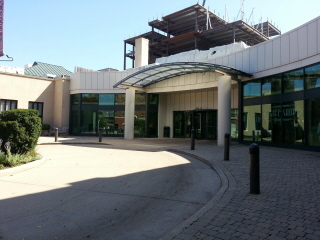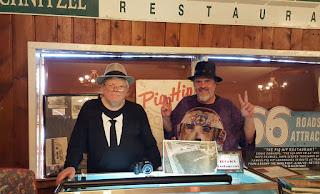Day Two of Joliet Trip
The Joliet Area Historical Museum and Route 66 Welcome Center on Ottawa Street was indeed ready and welcoming when we arrived there shortly after 10 am on Friday. At the admissions and gift counter was Elaine Stonich, who I had talked to the previous weekend at the Route 66 Association of Illinois' annual picnic. And Heather Bigeck, Exhibits and Collections Manager for the museum, was waiting for us with picture files that she knew would interest us. And interest us they did. We acquired some wonderful images with permission to use them in our new book. Heather came to the museum with experience and interest in Native American culture (an interest of mine as well), but in her six years in Joliet has learned its history. She was great!
Of course we toured the museum while we were there - very nicely done. The museum portion is contained within the former Ottawa Street Methodist Church building, with the newer building addition functioning as the Route 66 Welcome Center and gift shop.
Heading north for Lockport, we passed the old Joliet Prison on Collins Street. We knew we'd be back to take a closer look later but needed to allow time at the Will County Historical Society before they closed. I found Lockport to be a rather charming city with a lot of traffic (for a community of 24,000), many historic buildings, and signs of revitalization and a rather discerning clientele for its restaurants and shops. Lockport is steeped in I&M Canal history and contains part of the I&M Canal Heritage Corridor. The Historical Society itself is lodged in the historic 1830s I&M Canal office building. Executive Director Sandy Vasko was helpfulness itself and we acquired more information and photos.
Then...to the prison for a photo op. Some signage, some landscaping, and the most imposing structure towers over the parking lot. Just before this trip I read about a recent large fire here in the old warehouse, and how the firemen couldn't get in because the gates are welded shut. One newspaper reported that local residents saw the flames from three miles away. Although this was not a place I'd have wanted to be in, the building is huge and amazing. The architect was William W. Boyington, one of the earliest of Chicago's pantheon of great architects. Both the prison and the Chicago Water Tower were designed by Boyington and built of Joliet limestone. This huge prison building was constructed with convict labor and opened in 1858 and was in use until 2002. Many of the additional prison campus buildings are still in evidence in the neighborhood.
By then it was dinner time and we drove north to dine at the iconic Dell Rhea Chicken Basket. The food was delicious, service efficient and friendly, and the portions way too big. And there's neon inside, too.
Of course we toured the museum while we were there - very nicely done. The museum portion is contained within the former Ottawa Street Methodist Church building, with the newer building addition functioning as the Route 66 Welcome Center and gift shop.
Heading north for Lockport, we passed the old Joliet Prison on Collins Street. We knew we'd be back to take a closer look later but needed to allow time at the Will County Historical Society before they closed. I found Lockport to be a rather charming city with a lot of traffic (for a community of 24,000), many historic buildings, and signs of revitalization and a rather discerning clientele for its restaurants and shops. Lockport is steeped in I&M Canal history and contains part of the I&M Canal Heritage Corridor. The Historical Society itself is lodged in the historic 1830s I&M Canal office building. Executive Director Sandy Vasko was helpfulness itself and we acquired more information and photos.
Then...to the prison for a photo op. Some signage, some landscaping, and the most imposing structure towers over the parking lot. Just before this trip I read about a recent large fire here in the old warehouse, and how the firemen couldn't get in because the gates are welded shut. One newspaper reported that local residents saw the flames from three miles away. Although this was not a place I'd have wanted to be in, the building is huge and amazing. The architect was William W. Boyington, one of the earliest of Chicago's pantheon of great architects. Both the prison and the Chicago Water Tower were designed by Boyington and built of Joliet limestone. This huge prison building was constructed with convict labor and opened in 1858 and was in use until 2002. Many of the additional prison campus buildings are still in evidence in the neighborhood.
By then it was dinner time and we drove north to dine at the iconic Dell Rhea Chicken Basket. The food was delicious, service efficient and friendly, and the portions way too big. And there's neon inside, too.






Comments
Post a Comment